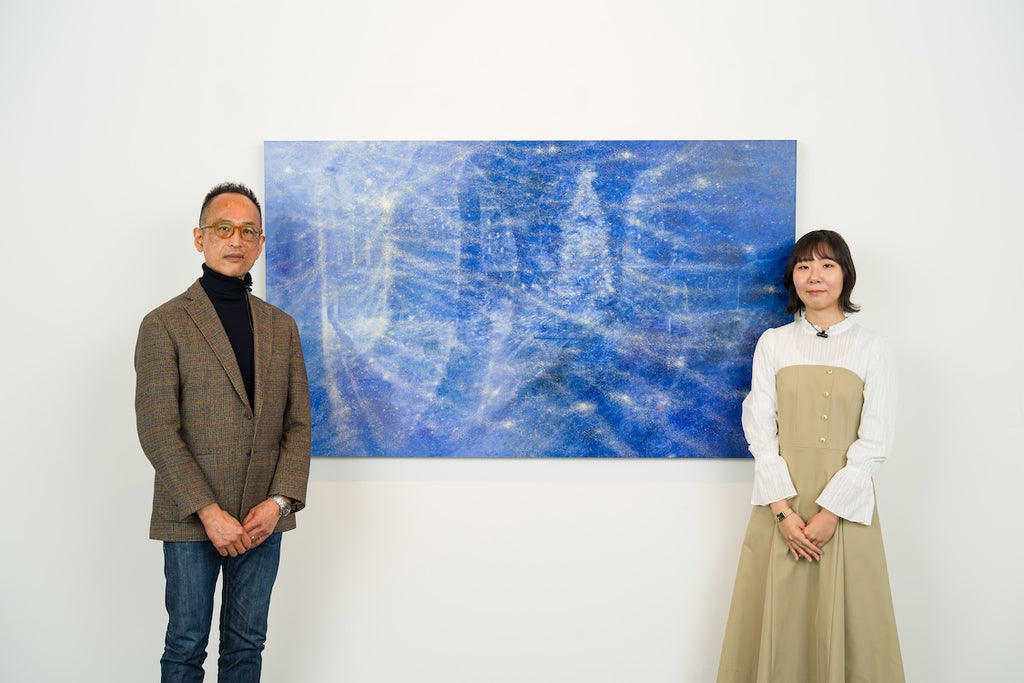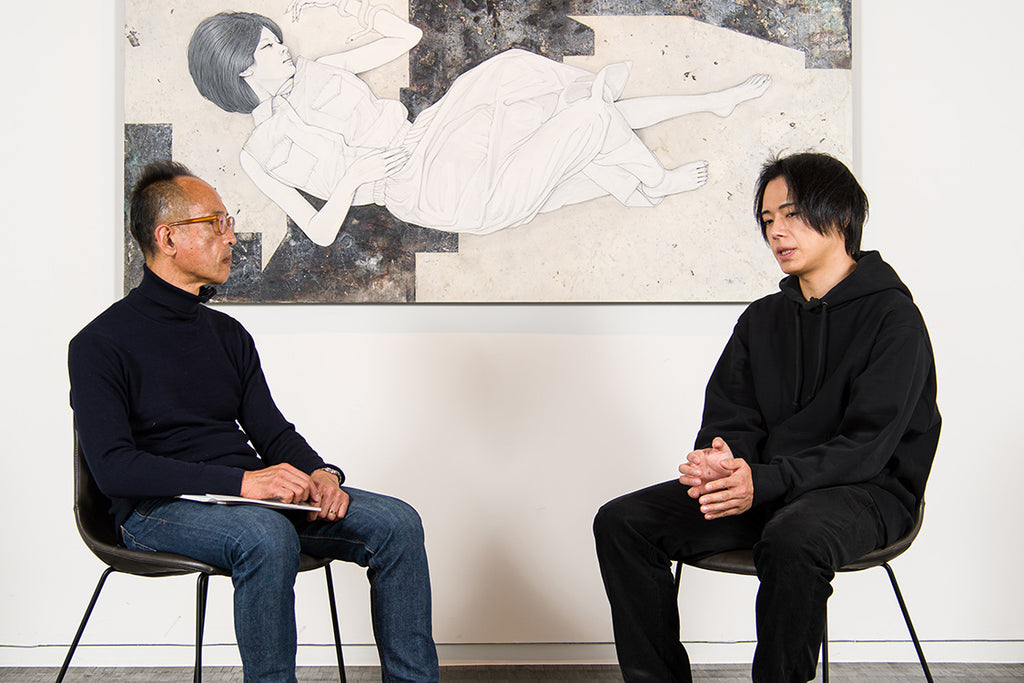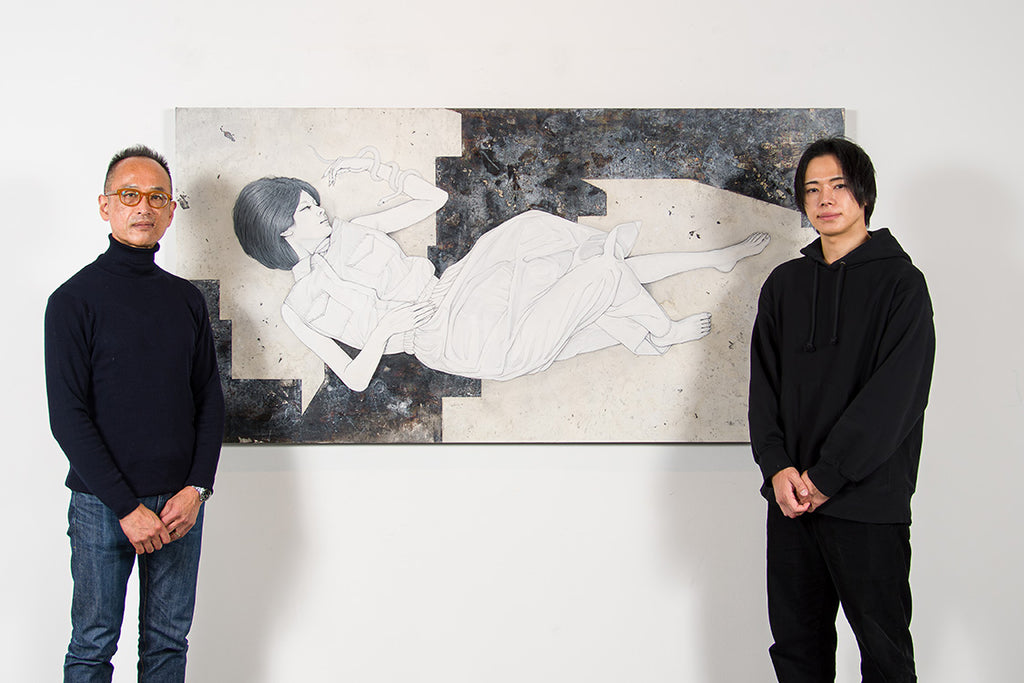ARTICLES
Karen Shiozawa × Meiji Hijikata | Dreamlike Brushstrokes that Evoke Empathy
2024.05.10
INTERVIEW

Meiji Hijikata × Karen Shiozawa
This series of articles delves into conversations between various artists and Meiji Hijikata, Director of the Taro Okamoto Museum of Art, Kawasaki, providing an in-depth exploration of their artworks. The fifth installment features a dialogue with Karen Shiozawa, an artist known for her sensory-rich expressions.
How did spending her formative years in the Netherlands influence Shiozawa's current works, and how does it shape her communication with viewers? Through his unique perspectives, Hijikata unravels the charm of Shiozawa's art, juxtaposing it with the local culture and distinctive artistic history of the Netherlands.
Footprints from Her Childhood: A Formative Experience in the Netherlands

Installation view of Shiozawa's exhibition in South Korea
Hijikata: I want to ask about your life's journey up to this point. Where were you born?
Shiozawa: I was born in Japan, but I moved to the Netherlands when I was one year old, eventually returning home just before turning five.
Hijikata: So you spent your early childhood in the Netherlands. Did that experience significantly influence how you paint and perceive the world?
Shiozawa: Yes, it did. The experience of traveling the wide world and growing up in nature during my formative years has certainly influenced my work. But more than that, it was the strange experiences I had during my childhood that have become the themes of my art.
Hijikata: I visited the Netherlands in my younger years, though only briefly. I remember it well and found its culture quite distinctive within Europe. Can you share more about those unique childhood experiences?
Shiozawa: One of my most vivid memories is attending a local kindergarten. Among children of various nationalities, we often communicated through simple methods like drawing pictures or singing songs, especially when I couldn't speak the language well. These strong memories remind me that the essence of communication can be very simple. This insight continues to influence my art, as I often draw on childhood memories and experiences for my themes.
Fairy Tale Scenes that Nurtured Her Inner World

Installation view of Shiozawa's exhibition in South Korea
Hijikata: Did you live in a place of rich nature when you were small?
Shiozawa: I lived in Amsterdam, and our house was surrounded by a vast grassland with scattered trees. I still remember the sight of several small houses dotting the landscape.
Hijikata: It sounds like a scene from a fairy tale.
Shiozawa: It truly was like a fairy tale. That’s probably why I enjoy painting such scenery.
Hijikata: The Netherlands has a renowned history of painting both indoor scenes and landscapes, partly due to its relatively relaxed stance on religious restrictions compared to its European neighbors. This has led to the country pioneering the idea of expressing one’s inner or personal world through art. Your paintings also seem to explore your inner, personal world, don't they?
Shiozawa: Yes, these days, I am particularly interested in expressing and depicting the memories and emotions that come from within, as well as the feelings that stem from individual human experiences.
Lyrical Landscapes Painted by the Dutch Sunlight

Meiji Hijikata
Hijikata: When I was considering what to discuss with you, a documentary came to mind—"Dutch Light" by Pieter-Rim de Kroon (1955-). It’s highly acclaimed in the art world and explores how a unique quality of Dutch light influenced artists like Rembrandt and Vermeer. Have you ever been conscious of this Dutch light in your own work?
Shiozawa: I hadn't noticed it before, but now that I'm older, I see parallels between my paintings and those of some Dutch artists. There might be similarities in the light, coloration, or warm atmosphere. It's difficult to articulate, but I do sense something distinct.
I particularly feel it in the yellow lights and the warm ambiance. In the part of the Netherlands where I lived, the landscape was serene, lined with pastoral houses, and the morning sunlight on that scene remains vivid in my memory. I believe these similarities and my own artistic roots lie in those early experiences.
Karen Shiozawa: Secret Place - Finally met
The Summer that Opened the Door to Art

Installation view of Shiozawa's exhibition in South Korea
Hijikata: What made you decide to attend an art university?
Shiozawa: I started seriously considering attending an art university during the summer of my second year in high school. At that time, I was uncertain about my future career path. Coincidentally, there was a painting competition, and I decided to submit a piece that I truly wanted to create. The result was an oil painting titled "Memory," which depicted people of various nationalities in a contemporary setting.
Creating that painting was the most enjoyable experience I'd ever had, and it even won an award in the exhibition. This recognition made me realize that I could potentially pursue a career in art. Though I was unsure how it would turn out, I felt it was worth giving it a shot.
Towards the Pursuit of Light and Communication

Karen Shiozawa
Hijikata: After entering the art university, what kind of paintings did you create?
Shiozawa: At the time, I liked creating surrealist-like paintings and paintings that were somewhat representational, similar to the works of Salvador Dali (1904-1989).
Hijikata: I was not expecting you to mention Dali, but in the realm of surrealism, I think the works of Leonora Carrington (1917-2011) come close to the world of your art. She was an artist who moved from France to Mexico where she became absorbed in surrealism through the influence of artists like Max Ernst. Her paintings were truly mystical, and I feel an affinity between her art and yours.
Shiozawa: I made paintings like that when I was in my first year of undergraduate studies. But when I was in my third year, I got an opportunity to learn about Giorgio de Chirico (1888-1978). I got drawn to his dreamlike world, and I felt that he was genuinely painting the things he wanted to paint. Through my research on his works, I began to think that I should express the things I want to paint in an abstract manner. For my graduation project, I used a whole room to set up a painting and art installation for the first time, creating an expression of the world I wanted to create.
Hijikata: What kind of world was it, specifically?
Shiozawa: To put it simply, I would say that it was a dreamlike world.
Hijikata: Similar to the world of Giorgio de Chirico?
Shiozawa: It was both reality and unreality. During my fourth undergraduate year, I wanted to express something that emerges from a shift in consciousness.

Installation view of Shiozawa's exhibition in South Korea
Hijikata: Do you usually think about such things consciously?
Shiozawa: I probably do it unconsciously. I try to pick up the things that spilled over from my mind unconsciously by looking back on what I was thinking at the time, and that is basically what becomes my painting.
Hijikata: It seems to be something close to the dream world.
Shiozawa: Yes, it is. For my graduation project, the unrealistic elements were too strong, making it feel too introspective. As I entered graduate school and I started getting more opportunities to have my works seen by many people, I began to think about the communication aspect of my works, wondering how I can convey what I want to express to others.
It was when I was exploring different ways to share my world with others that I began to create artworks with the theme of "light". I had been depicting light in my paintings before, but when I decided to focus on the simple idea of "light" as a theme, I felt within myself that my works opened up and expanded to new horizons.
Hijikata: So it was during graduate school that you became more conscious of conveying your art to others. Would you say that you went back to your childhood experience where painting served as a spark for communication?
Shiozawa: More than going back, I would say that I realized how I should cherish the feelings that arise from sharing the parts that had been previously self-contained within my own world. When that happened, I knew that I needed to open up what was inside my world.
Hijikata: That mentality is truly important, and without it, art becomes something for self-satisfaction. Great artworks have the power to convey something to others while still expressing its own world thoroughly. The ability to move people or make them empathize is a hallmark of a first-rate piece. It is truly remarkable how you realized the importance of expanding and liberating your world, rather than just painting to please others. In a sense, this process is a testament to why your current works resonate with many people.

Meiji Hijikata × Karen Shiozawa
Karen Shiozawa has continuously delved into the realm of communication that transcends the spoken word. Her oeuvre captures a mystical world shaped by her formative experiences. Each piece is imbued with the gentle afternoon sunlight, the fiery hues of a sunset descending between urban edifices, and the serene glow of moonlight gracing the night. No two lights are the same, and through her paintings, Shiozawa's singular experiences and memories are brought to life, forging a deep emotional connection with her audience.
In the first installment of this insightful dialogue, we explore Karen Shiozawa's creative processes and the thematic underpinnings of her exhibitions. We invite you to immerse yourself in this compelling discussion.
First Part: The Depths of the Heart Projected by a Magical Light



